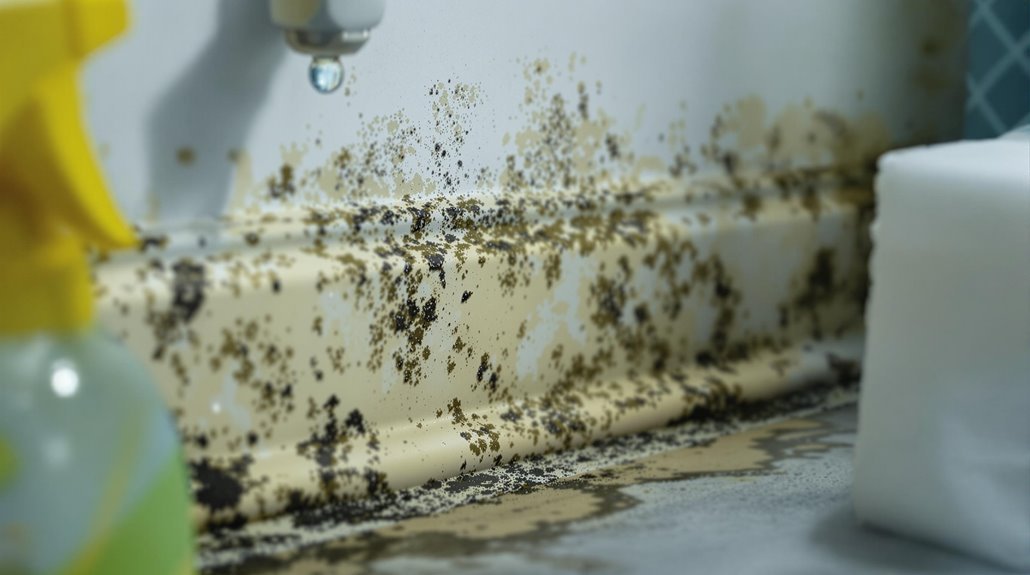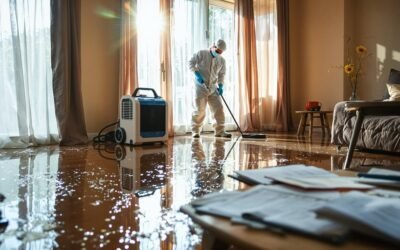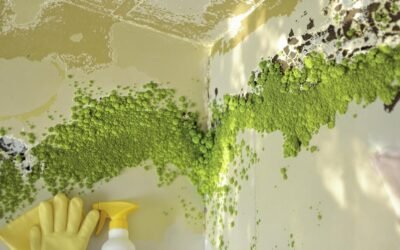Mold can start growing just 24 to 48 hours after a water leak, so swift action is vital. To prevent mold growth, reduce humidity levels below 60%, immediately shut off the water supply, and remove any excess water. Guarantee proper ventilation in damp areas to maintain airflow. Utilize mold-resistant materials and routinely inspect your home for potential leaks or moisture buildup. If you notice any signs of mold or persistent dampness, don't hesitate to contact professionals for assistance. Taking these proactive steps today can help guarantee a healthier home in the future, revealing more fundamental strategies for effective mold management.
Key Takeaways
- Mold spores can germinate within 24-48 hours after a water leak under favorable conditions.
- Visible mold signs may appear in as little as 24-48 hours if moisture persists.
- High humidity levels above 60% significantly accelerate mold growth; controlling humidity is essential.
- Immediate water removal and proper ventilation are crucial in preventing mold colonization.
- Regular inspections and maintenance can help identify leaks early, reducing mold risk.
Understanding Mold Growth

When you experience a water leak, it's crucial to understand how mold growth can begin rapidly in your environment. Mold spores are ubiquitous, floating in the air and waiting for the right conditions to thrive. When moisture from a leak saturates surfaces, it creates an ideal environment for these spores to germinate. The growth conditions mold requires include warmth, moisture, and organic material, which are often present in homes. Within 24 to 48 hours after a leak, mold can start to colonize if these conditions persist. Recognizing this urgency can help you take immediate action to mitigate mold risks, like drying out affected areas and ensuring proper ventilation. Additionally, professional mold remediation services can effectively address mold issues before they escalate. Awareness of these factors is key to preventing extensive mold development.
Timeline for Mold Development
While mold can start to develop within just a day or two after a water leak, the timeline for visible growth often varies based on several factors. Different mold types exhibit distinct growth rates, influenced by their specific growth conditions. For instance, certain molds thrive in warm, humid environments, while others prefer cooler, damp spaces. Typically, you might notice signs of mold within 24 to 48 hours if conditions are right. Nevertheless, in less favorable circumstances, it could take several days or even weeks for visible growth to appear. Monitoring moisture levels and keeping your environment dry can help you manage and prevent mold development effectively. Understanding this timeline allows you to act swiftly in preventing more extensive mold issues. Additionally, prompt water removal services can significantly reduce the risk of mold growth following a water leak.
Factors Influencing Mold Growth

Moisture levels and temperature conditions are critical factors that influence mold growth in your home. High humidity and warm temperatures create an ideal environment for mold to thrive. Understanding how these elements interact helps you take preventive measures against mold development after a water leak.
Moisture Levels
Understanding the factors that influence mold growth requires a close examination of moisture levels, as they play a crucial role in the proliferation of mold spores. High moisture levels create an ideal environment for mold to thrive. To effectively manage this risk, you need to focus on several aspects of moisture measurement and humidity control:
- Relative Humidity: Aim for levels below 60% to deter mold.
- Water Source: Identify and eliminate any leaks or sources of excess moisture.
- Ventilation: Guarantee proper airflow in damp areas like basements and bathrooms.
- Material Saturation: Monitor how quickly materials absorb moisture after a leak.
Temperature Conditions
Temperature conditions greatly influence mold growth, as most fungi thrive in warm environments. The temperature impact on mold proliferation is significant; ideally, mold flourishes between 77°F and 86°F (25°C to 30°C). When temperatures rise within this range, you create ideal conditions for mold spores to germinate and spread rapidly. Conversely, cooler temperatures can slow down or inhibit growth, but don't eliminate the risk entirely. Even in less-than-ideal conditions, such as basements or attics, mold can persist if moisture is present. Consequently, maintaining a controlled environment, ideally below 70°F (21°C), can help mitigate mold risks. By understanding these temperature dynamics, you can take proactive measures to prevent mold growth following a water leak.
Types of Mold Commonly Found
When a water leak occurs, various types of mold can begin to thrive in the damp environment. Understanding these molds is essential for your health and home. Here are some common types you might encounter:
- Black Mold: Often found in damp areas, it's known for its dark appearance and potential health risks.
- Toxic Mold: This term typically refers to molds that produce mycotoxins, which can pose serious health threats.
- Aspergillus: Common in decaying organic material, it can lead to respiratory issues.
- Penicillium: Frequently found in water-damaged buildings, it can cause allergic reactions.
Being aware of these molds can help you take proactive measures to prevent their growth after a leak.
Signs of Mold Presence

You might notice visible mold growth on walls, ceilings, or hidden areas after a water leak. Furthermore, a musty odor can indicate mold presence, often signaling moisture problems. Recognizing these signs early can help you address mold issues before they escalate.
Visible Mold Growth
Visible mold growth often serves as a clear indicator of moisture issues in any environment. When you're evaluating a space, keep an eye out for visible mold identification, which can take several forms. Noticing these signs is essential, as mold can lead to significant health effects. Here are some common signs to look for:
- Dark or colored patches on walls or ceilings
- A fuzzy or slimy texture on surfaces
- Stains that appear to grow over time
- A presence in damp or humid areas, such as bathrooms
Musty Odor Presence
Alongside visible mold growth, a musty odor often signals the presence of mold in your space. This distinct smell detection can indicate that mold spores are thriving in damp conditions. If you notice a persistent musty odor, it's important to investigate further, as it may be a precursor to more significant mold issues. Often, this odor arises from hidden mold colonies in walls, ceilings, or under flooring, which can be challenging to detect visually. Ignoring a musty smell can lead to health problems and structural damage. As a result, addressing the source of the odor promptly is vital. Conducting thorough inspections and maintaining proper ventilation can help prevent mold growth and manage any musty odors effectively.
Immediate Actions After a Leak
When a water leak occurs, addressing the situation promptly is essential to prevent mold growth and minimize damage. Your immediate response can greatly reduce water damage and the need for extensive repairs. Here's what you should do right away:
- Shut off the water supply to stop further leakage.
- Turn off electricity in affected areas to prevent hazards.
- Remove excess water using towels or a wet/dry vacuum if safe to do so.
- Contact a professional for emergency response to assess and mitigate damage.
Taking these steps quickly can help safeguard your property and limit the conditions that encourage mold growth. Always remember, the sooner you act, the better your chances of avoiding serious issues down the line.
Drying Techniques to Prevent Mold

To effectively prevent mold growth after a water leak, you need to focus on efficient air circulation and moisture removal methods. Utilizing fans and dehumidifiers can greatly reduce humidity levels, which inhibits mold development. Implementing these techniques promptly is essential for safeguarding your environment.
Effective Air Circulation
Effective air circulation is crucial for drying out areas affected by water leaks, as it greatly reduces the risk of mold growth. By focusing on airflow management and humidity control, you can create an environment less favorable to mold proliferation. Here are some effective techniques to improve air circulation:
- Use fans to promote consistent airflow in affected areas.
- Open windows to allow fresh air to circulate and reduce humidity levels.
- Employ dehumidifiers to extract excess moisture from the air.
- Confirm vents and ducts are unobstructed for ideal air movement.
Implementing these strategies will help dry out spaces quickly and effectively, minimizing the chances of mold development after a water leak.
Moisture Removal Methods
Since rapid moisture removal is essential for preventing mold growth, employing various drying techniques can greatly mitigate risk after a water leak. Here are some effective methods to take into account:
| Method | Description | Benefits |
|---|---|---|
| Air Drying | Utilizing fans and natural airflow | Cost-effective, easy |
| Dehumidifiers | Removing moisture from the air | Efficient moisture extraction |
| Desiccant Use | Using materials like silica gel | Absorbs excess humidity |
| Heat Treatment | Applying heat to affected areas | Accelerates drying |
Importance of Proper Ventilation
While mold thrives in damp environments, proper ventilation acts as a crucial barrier against its growth. Ensuring effective ventilation systems in your space helps to circulate indoor air, reducing humidity levels and preventing mold formation. Here are key benefits of maintaining proper ventilation:
- Improved Indoor Air Quality: Fresh air circulation reduces pollutants and allergens.
- Reduced Humidity: Lower moisture levels discourage mold spores from settling.
- Temperature Regulation: Helps maintain a consistent indoor temperature, preventing condensation.
- Odor Control: Eliminates musty smells associated with mold growth.
Mold-Resistant Materials and Products

When considering ways to prevent mold growth, incorporating mold-resistant materials and products into your building or renovation projects can be a considerable breakthrough. Mold resistant paints, for instance, provide a protective barrier against moisture, inhibiting mold spores from settling and proliferating. Likewise, using mold resistant drywall, often treated with special additives, can considerably reduce the risk of mold development, especially in damp environments like basements and bathrooms. These materials not only contribute to a healthier living space but additionally save you money in potential remediation costs down the line. By choosing these innovative solutions, you're taking proactive steps to improve your property's durability and safety, ensuring that mold doesn't become an unwelcome guest in your home.
Regular Maintenance Tips
To effectively prevent mold growth, it's vital to establish a routine maintenance plan that addresses potential moisture issues before they escalate. Regular inspections and seasonal maintenance can markedly reduce the risk of mold formation in your home. Here are some fundamental tips to incorporate into your routine:
- Conduct routine inspections of roofs, gutters, and downspouts to guarantee proper drainage.
- Check for leaks in plumbing and appliances, fixing any issues immediately.
- Maintain humidity levels below 60% using dehumidifiers in damp areas.
- Clean and inspect HVAC systems regularly to prevent moisture buildup.
When to Call Professionals

Recognizing when to call professionals can be crucial in preventing mold growth after a water leak. If you notice persistent dampness, or if the affected area exceeds a few square feet, it's time to seek a professional inspection. Professional inspectors can assess the extent of the damage and identify hidden moisture that you might miss. Furthermore, if you see visible mold growth, don't hesitate to call in experts. Mold remediation requires specialized techniques and equipment that most homeowners lack. Ignoring the problem can lead to health risks and structural damage. By acting swiftly and consulting professionals, you guarantee a thorough cleanup and reduce the likelihood of mold returning. Don't wait—address water leaks and potential mold risks promptly.
Conclusion
Just like a garden needs water to flourish, mold thrives in damp conditions. If you spot a leak, don't wait for the storm to pass; act swiftly to prevent a fungal invasion. By understanding mold's timeline and taking preventive measures—like ensuring proper ventilation and using mold-resistant materials—you can safeguard your home. Remember, a diligent gardener tends to their plants; similarly, regular maintenance will keep your living space healthy, inviting, and mold-free.




